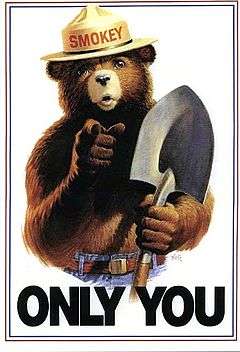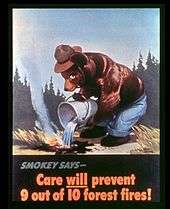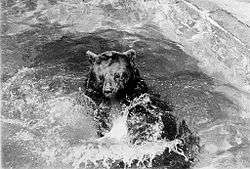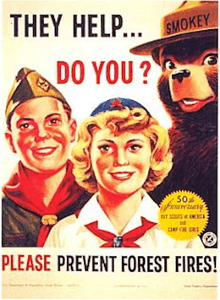Smokey Bear
| Smokey Bear | |
|---|---|
 Smokey Bear in a poster based on the "Uncle Sam/Lord Kitchener" poster | |
| First appearance | 1944 |
| Created by | Advertising Council |
Smokey Bear is an American advertising mascot created by the Ad Council with artist Albert Staehle,[1][2] possibly in collaboration with writer and art critic Harold Rosenberg.[3] It is administered by the Ad Council, the United States Forest Service, and the National Association of State Foresters to educate the public about the dangers of wildfires. A campaign featuring Smokey and the slogan "Smokey Says – Care Will Prevent 9 out of 10 Forest Fires" began in 1944. His later slogan, "Remember... Only YOU Can Prevent Forest Fires" was created in 1947. In April 2001, the message was updated to "Only You Can Prevent Wildfires."[4] According to the Ad Council, he and his message are recognized in the United States by 95% of adults and 77% of children.[5]
In 1952, the songwriters Steve Nelson and Jack Rollins had a successful song named "Smokey the Bear". The pair said "the" was added to Smokey's name to keep the song's rhythm.[6] During the 1950s, that variant of the name became widespread both in popular speech and in print, including at least one standard encyclopedia.[7] A 1955 book in the Little Golden Books series was called Smokey the Bear and he calls himself by this name in the book. It depicted him as an orphaned cub rescued in the aftermath of a forest fire. From the beginning, his name was intentionally spelled differently from the adjective "smoky".
Smokey Bear's name and image are protected by U.S. federal law, the Smokey Bear Act of 1952 (16 U.S.C. 580 (p-2); 18 U.S.C. 711).[8][9]
Campaign beginnings

Although the U.S. Forest Service fought wildfires long before World War II, the war brought a new importance and urgency to the effort. The forest service began using colorful posters to educate Americans about the dangers of forest fires. Since most able-bodied men were already serving in the armed forces, none could be spared to fight forest fires on the West Coast. The hope was that local communities, educated about the danger of forest fires, could prevent them from starting in the first place.[10]
On August 13, 1942, Disney's fifth full-length animated motion picture Bambi premiered in New York City. Soon after, Walt Disney allowed his characters to appear in fire prevention public service campaigns. However, Bambi was only loaned to the government for a year, so a new symbol was needed. A bear was chosen. His name was inspired by "Smokey" Joe Martin, a New York City Fire Department hero who suffered burns and blindness during a bold 1922 rescue.[11]

Smokey's debut poster was released on August 9, 1944, which is considered the character's birthday.[2] Overseen by the Cooperative Forest Fire Prevention Campaign, the first poster was illustrated by Albert Staehle. In it Smokey was depicted wearing jeans and a campaign hat,[12] pouring a bucket of water on a campfire. The message underneath reads, "Smokey says – Care will prevent 9 out of 10 forest fires!" Knickerbocker Bears gained the license to produce Smokey Bear dolls in 1944.[13] Also in 1944, Forest Service worker Rudy Wendelin became the full-time campaign artist; he was considered Smokey Bear's "manager" until Wendelin retired in 1973.[2]
In addition, during World War II, the Empire of Japan considered wildfires as a possible weapon. During the Lookout Air Raids of September 1942, the Japanese military attempted without success to set ablaze coastal forests in southwest Oregon. U.S. planners also hoped that if Americans knew how wildfires would harm the war effort, they would better cooperate with the Forest Service to eliminate any kind of fire.[10] The Japanese military renewed their wildfire strategy late in the war: from November 1944 to April 1945, launching some 9,000 fire balloons into the jet stream, with an estimated 10% reaching the U.S. In the end only five school children and their teacher, Elsie Mitchell, were killed by one of the bombs near Bly, Oregon, on May 5, 1945.[14] A memorial was erected at what today is called the Mitchell Recreation Area.
In 1947, the slogan associated with Smokey Bear for more than five decades was finally coined: "Remember ... only YOU can prevent forest fires."[15] In 2001, it was officially amended to replace "forest fires" with "wildfires", as a reminder that other areas (such as grasslands) are also in danger of burning.[16]
Living symbol

The living symbol of Smokey Bear was an American black bear three-month-old cub who in the spring of 1950 was caught in the Capitan Gap fire, a wildfire that burned 17,000 acres (69 km2) in the Lincoln National Forest,[16] in the Capitan Mountains of New Mexico. Smokey had climbed a tree to escape the blaze, but his paws and hind legs had been burned. According to some stories, he was rescued by a game warden after the fire, but according to the New Mexico State Forestry Division, it was actually a group of soldiers[17] from Fort Bliss, Texas, who had come to help fight the fire, that discovered the bear cub and brought him back to the camp.[18]

At first he was called Hotfoot Teddy, but he was later renamed Smokey, after the mascot. There are conflicting stories regarding the individual or individuals who first helped nurse the cub after the fire. According to the New York Times obituary for Homer C. Pickens, then Assistant Director of the New Mexico Department of Game and Fish, he kept the cub at his home for a while, trying to nurse him back to health.[16] According to other records, including a story in Life magazine, New Mexico Department of Game and Fish Ranger Ray Bell took him to Santa Fe, where he, his wife Ruth, and their children Don and Judy cared for the cub.[18] The story was picked up by the national news services and Smokey became a celebrity. Soon after, Smokey was flown in a Piper Cub airplane to the National Zoo in Washington, D.C. A special room was prepared for him at the St. Louis zoo for an overnight fuel stop during the trip, and when he arrived at the National Zoo, several hundred spectators, including members of the Boy Scouts, Girl Scouts, photographers, and media, were there to welcome him.[19]

Smokey Bear lived at the National Zoo for 26 years. During that time he received millions of visitors as well as so many letters addressed to him (up to 13,000 a week) that in 1964 the United States Postal Service gave him his own ZIP code (20252).[19] He developed a love for peanut butter sandwiches, in addition to his daily diet of bluefish and trout.[19]
Upon his death on November 9, 1976,[20] Smokey's remains were returned by the government to Capitan, New Mexico, and buried at what is now the Smokey Bear Historical Park.[21] The plaque at his grave reads, "This is the resting place of the first living Smokey Bear ... the living symbol of wildfire prevention and wildlife conservation."[22] The Washington Post ran a semi-humorous obituary for Smokey, labeled "Bear", calling him a transplanted New Mexico native who had resided for many years in Washington, D.C., with many years of government service. It also mentioned his family, including his wife, Goldie Bear, and "adopted son" Little Smokey. The obituary noted that Smokey and Goldie were not blood-relatives, despite the fact that they shared the same "last name" of "Bear".[23] The Wall Street Journal included an obituary for Smokey Bear on the front page of the paper, on November 11, 1976,[19] and so many newspapers included articles and obituaries that the National Zoo archives include four complete scrapbooks devoted to them (Series 12, boxes 66-67).[24]
Smokey Bear II
In 1962, Smokey was paired with a female bear, "Goldie Bear", with the hope that perhaps Smokey's descendants would take over the Smokey Bear title.[22] In 1971, when the pair still had not produced any young, the zoo added "Little Smokey", another orphaned bear cub from the Lincoln Forest, to their cage—announcing that the pair had "adopted" this cub.
On May 2, 1975, Smokey Bear officially "retired" from his role as living mascot, and the title, "Smokey Bear II", was bestowed upon Little Smokey in an official ceremony.[19] He died August 11, 1990.[22]
Upon his death Smokey's remains were transported to a U.S. Forest Service facility in Capitan, where he was buried. The facility is now a forest fire/Smokey interpretive center. In the garden adjacent to the interpretive center is the bear's grave. Thousands every year stop by to pay homage.
Popularity
The character became a notable part of American popular culture in the 1950s. He appeared on radio programs, in comic strips, and in cartoons.
In 1952, after Smokey Bear attracted considerable commercial interest, the Smokey Bear Act, an act of Congress, was passed to remove the character from the public domain and place it under the control of the Secretary of Agriculture. The act provided for the use of Smokey's royalties for continued education on the subject of forest fire prevention. More than three million dollars have been collected.[25]
A Smokey Bear doll was produced by Ideal Toys beginning in 1952; the doll included a mail-in card for children to become Junior forest rangers. Within three years half a million children had applied. In April 1964, the character was given his own ZIP code (postal code): 20252.[26]
In 1955, the first children's book was published, followed by many sequels and coloring books. Soon thousands of dolls, toys, and other collectibles were on the market.
During the 1950s and 1960s, the Ad Council sponsored radio advertisements, featuring Smokey Bear "in conversation" with prominent American celebrity stars such as Bing Crosby, Art Linkletter, Dinah Shore, and Roy Rogers.[27]
In 1959, on an episode of Rocky and Friends, there was a Dudley Do-Right episode entitled "Stokey The Bear" which was a parody of Smokey. As a result, this episode was eliminated from further distribution. However, it was revived on DVD in 2005 for "The Complete Rocky and Bullwinkle and Friends".
Smokey's name and image has been loaned to the Smokey Bear Awards, which are awarded by the United States Forest Service to "recognize outstanding service in the prevention of wildland fires and to increase public recognition and awareness of the need for continuing fire prevention efforts."[28]
Though Smokey was originally drawn wearing the campaign hat of the U.S. National Park Service (which was in turn derived from the cavalry who protected the early U.S. national parks), the hat itself later became famous by association with the Smokey cartoon character. As such, it is sometimes today called a "Smokey Bear" hat by both the military service branches and state police who still employ it. For that reason, truck drivers often refer to state police officers as "Smokey" or "bears".
Legacy

For Smokey’s 40th anniversary in 1984, he was honored with a U.S. postage stamp that pictured a cub hanging onto a burned tree. It was illustrated by Rudy Wendelin. The commercial for his 50th anniversary portrayed woodland animals about to have a surprise birthday party for Smokey, with a cake with candles. When Smokey comes blindfolded, he smells smoke, not realizing it is birthday candles for his birthday. He uses his shovel to destroy the cake. When he takes off his blindfold, he sees that it was a birthday cake for him and apologizes.[29]
In 2004, Smokey's 60th anniversary was celebrated in several ways, including a Senate resolution designating August 9, 2004, as "Smokey Bear 60th Anniversary", calling upon the President to issue a proclamation "calling upon the people of the United States to observe the day with appropriate ceremonies and activities."[30]
According to Richard Earle, author of The Art of Cause Marketing, the Smokey Bear campaign is among the most powerful and enduring of all public service advertising: "Smokey is simple, strong, straightforward. He's a denizen of those woods you're visiting, and he cares about preserving them. Anyone who grew up watching Bambi realizes how terrifying a forest fire can be. But Smokey wouldn't run away. Smokey's strong. He'll stay and fight the fire if necessary, but he'd rather have you douse it and cover it up so he doesn't have to."[31]
On the anniversary of finding Smokey Bear in the Capitan Gap fire, May 9, 2000, Marianne Gould from the Smokey Bear Ranger District, Eddie Tudor from the Smokey Bear Museum and Neal Jones from the local Ruidoso, New Mexico radio station created "Smokey Bear Days". The event celebrates the fire prevention message from the Smokey Bear campaign as well as wilderness environment conservation with music concerts, chainsaw carving contests, a firefighter's "muster" competition, food, vendors and a parade. The "Smokey Bear Days" celebration is held in Smokey's hometown of Capitan, New Mexico the first weekend of May every year.[32]
In 2008 through 2011, new commercials featuring Smokey rendered in CGI were released.
Voices
Washington, D.C., radio station WMAL personality Jackson Weaver served as the primary voice representing Smokey until Weaver's death in October 1992. Others who have provided a voice to Smokey include Jim Cummings, Roger C. Carmel, Jack Angel, Los Angeles radio station KNX's George Walsh, and Gene Moss. In June 2008, the Forest Service launched a new series of public service announcements voiced by actor Sam Elliott, simultaneously giving Smokey a new visual design intended to appeal to young adults. Patrick Warburton provides the voice of an anonymous park ranger.
Adaptations

Smokey Bear — and parodies of the character — have been appearing in animation for more than fifty years. In 1956, he made a cameo appearance in the Walt Disney short film In the Bag with a voice provided by Jackson Weaver.
Rankin/Bass Productions, in cooperation with Tadahito Mochinaga's MOM Production in Japan, produced an "Animagic" stop motion animated television special, The Ballad of Smokey the Bear, narrated by James Cagney. It aired on November 24, 1966 as part of the General Electric Fantasy Hour on NBC. During the 1969–1970 television season, Rankin/Bass also produced a weekly Saturday Morning cartoon series for ABC, The Smokey the Bear Show. This series is animated by Toei Animation in Japan.
Steve Nelson and Jack Rollins's song "Smokey the Bear" has been covered by the group Canned Heat, among others. The track is on their CD The Boogie House Tapes 1969-1999.
"Smokey the Bear Sutra" is a 1969 poem by Gary Snyder, which presents environmental concerns in the form of a Buddhist sutra, and depicts Smokey as the reincarnation of the Great Sun Buddha.[33]
Fire ecology
The Smokey Bear campaign has been criticized by wildfire policy experts in cases where decades of fire suppression and the indigenous fire ecology were not taken into consideration, creating forests unnaturally dense with fuel.[34] Periodic low-intensity wildfires are an integral component of certain ecosystems that evolved to depend on natural fires for vitality, rejuvenation, and regeneration. Examples are chaparral and closed-cone pine forest habitats, which need fire for seeds and cones to sprout. Wildfires also play a role in the preservation of pine barrens, which are well adapted to small ground fires and rely on periodic fires to remove competing species.
When a brushland, woodland, or forested area is not impacted by fire for a long period, large quantities of flammable leaves, branches and other organic matter tend to accumulate on the forest floor and above in brush thickets. When a forest fire eventually does occur, the increased fuel creates a crown fire, which destroys all vegetation and affects surface soil chemistry. Frequent small 'natural' ground fires prevent the accumulation of fuel and allow large, slow-growing vegetation (e.g. trees) to survive. There is increasing use of controlled burns directed by skilled firefighters, and allowing wildland fires not causing human harm or threat to burn out.
The goal and theme of the Smokey Bear campaign was adjusted in the 2000s, from "Only you can prevent forest fires" to "Only you can prevent wildfires". The purpose is to respond to the criticism, and to distinguish 'bad' intentional or accidental wildfires from the needs of sustainable forests via natural 'good' fire ecology.[34]
See also
![]() Media related to Smokey Bear at Wikimedia Commons
Media related to Smokey Bear at Wikimedia Commons
- Johnny Horizon
- Mark Trail
- Woodsy Owl
- Reddy Red Squirrel
References
- ↑ "About the Campaign". SmokeyBear.com (Ad Council). Retrieved June 5, 2017.
On August 9, 1944, the creation of Smokey Bear was authorized by the Forest Service, and the first poster was delivered on October 10 by artist Albert Staehle.
- 1 2 3 Smokey Bear at Don Markstein's Toonopedia Archived from the original on June 5, 2017.
- ↑ Howe, Irving (1984). A Margin of Hope. Harvest Books. ISBN 978-0156572453. excerpted in "Arguing the World". (official website) PBS.
Harold Rosenberg had an enviable part-time job at the Advertising Council, where he created Smokey the [sic] Bear. (The sheer deliciousness of it: this cuddly artifact of commercial folklore as the creature of our unyielding modernist!)
The official Smokey Bear website the by Ad Council does not mention Rosenberg. No mention is made of Smokey Bear at Rosenberg's obituary at Russell, John (July 13, 1978). "Harold Rosenberg Is Dead at 72 Art Critic for The New Yorker". The New York Times. - ↑ "Campaign History". Ad Council. Retrieved 2010-08-08.
- ↑ "The Ad Council At A Glance". adcouncil.org. Archived from the original (PDF) on December 3, 2010. Retrieved 25 September 2009.
- ↑ "Only You Can Prevent Wildfires. - Resources". Archived from the original on February 28, 2007. Retrieved May 28, 2016.
- ↑ World Book Encyclopedia. Fire prevention. 1960.
- ↑ "Smokey Bear Act of 1952" (PDF). U.S. Public Law 82-359, 66 Stat. 92. Government Printing Office. May 23, 1952. p. 92.
- ↑ "History of Smokey Bear". U.S. Department of Agriculture Forest Service.
- 1 2 "Only You Can Prevent Wildfires". Smokey Bear. 7 December 1941. Retrieved 15 March 2014.
- ↑ Ralph Blumenthal (November 20, 2002). "Books of the Times: Their Battle Is Joined With an Inhuman Enemy". The New York Times. Retrieved May 28, 2016.
- ↑ "The story of the creation of Smokey Bear, told by the late Albert Staehle's wife". South-florida.us. Archived from the original on May 3, 2015. Retrieved 15 March 2014.
- ↑ "Knickerbocker Bears antique teddy bear encyclopedia". Luckybears.com. Archived from the original on March 31, 2014. Retrieved 15 March 2014.
- ↑ "Japanese balloon bomb killed six 60 years ago today". Herald and News. Retrieved May 28, 2016.
- ↑ "Only You Can Prevent Wildfires". Smokey Bear. Retrieved 15 March 2014.
- 1 2 3 "Homer Pickens, 91 - Saved Smokey Bear". The New York Times. February 23, 1995. Retrieved May 28, 2016.
- ↑ A June 2005 article in Smithsonian ("A Bear-Handed Grab", pp.47-48, identified the soldier as G. W. Chapman, who turned the injured bear over to a park ranger, who cared for him at his residence between veterinarian visits.
- 1 2 ""Smokey Bear 'The Living Symbol'", New Mexico State Forestry Division, Smokey Bear National Park information". Emnrd.state.nm.us. Retrieved 15 March 2014.
- 1 2 3 4 5 Tad Bennicoff (May 27, 2010). "Bearly Survived to become an Icon". The Bigger Picture. Smithsonian Institution Archives. Archived from the original on June 8, 2010. Retrieved May 28, 2016.
- ↑ Alex Hawes (December 2002). "Smokey Comes to Washington". Zoogoer. Smithsonian National Zoological Park. Archived from the original on February 23, 2009. Retrieved May 28, 2016.
- ↑ "Smokeybearpark.com". Smokeybearpark.com. Retrieved 15 March 2014.
- 1 2 3 John Kelly (April 25, 2010). "The biography of Smokey Bear: the cartoon came first". The Washington Post. Retrieved May 28, 2016.
- ↑ Larry Bleiberg (June 29, 1997). "New Mexico -- Town Still Celebrates Smokey Bear's Legend". The Dallas Morning News. Retrieved May 28, 2016.
- ↑ "National Zoological Park, Office of Public Affairs, Records". Record Unit 365. Smithsonian Institution Archives. Retrieved 28 March 2012.
- ↑ "History of the Cooperative Forest Fire Prevention Campaign". New Mexico State Forestry Division. Retrieved 25 July 2010.
- ↑ Lawter, William Clifford Jr. (1994). Smokey Bear 20252: A Biography. Lindsay Smith. ISBN 0964001713.
- ↑ "Forest Fire Prevention-Smokey Bear (1944-Present)". Ad Council. Retrieved 15 March 2014.
- ↑ "Smokey Bear Awards Fact Sheet" (PDF). National Symbols Cache. Archived from the original (PDF) on September 27, 2006. Retrieved May 28, 2016.
- ↑ "Only You Can Prevent Wildfires". Smokey Bear. Retrieved 10 August 2014.
- ↑ Congressional Record, Senate, July 22, 2004. Books.google.com. Retrieved 15 March 2014.
- ↑ Richard Earle (2000). The Art of Cause Marketing. New York: McGraw-Hill. p. 230.
- ↑ Neal Jones, originator of "Smokey Bear Days" 2000
- ↑ Snyder, Gary.
 Smokey the Bear Sutra. Wikisource.
Smokey the Bear Sutra. Wikisource. - 1 2 Mike Anton (July 24, 2009). "At 65, Smokey Bear is still fighting fires". Los Angeles Times. Retrieved May 28, 2016.
External links
- SmokeyBear.com
- A collection of Smokey Bear-related media
- The Real Smokey Bear - slideshow by Life magazine
- Inventory of the Rudolph Wendelin Papers, 1930 - 2005 in the Forest History Society Library and Archives, Durham, NC
- Smokey Bear Days
- The short film History of Smokey Bear (ncwg.gov) is available for free download at the Internet Archive
- Smokey's Story, from the Texas Archive of the Moving Image
